How To Fix A Misaligned Jaw

Many orthodontic patients suffer from a misaligned jaw that affects how teeth sit in the mouth and causes bite problems. Overbites, where the upper teeth protrude, and underbites, when the lower teeth sit out farther than the upper teeth, can cause physical and emotional discomfort. If left untreated, a misaligned jaw can affect how you eat, speak and sleep. Luckily, there are many types of orthodontic treatments and appliances that are used to correct misalignments and give you your confidence back. Find out what to do if you have a misaligned jaw with this guide!
What A Misaligned Jaw Looks Like
Many people receive orthodontic treatment to fix their crooked teeth, but braces can also resolve bite issues, as well. Braces are great ways to fix misaligned jaws in children and adults and help prevent the consequences of underbites and overbites. Misaligned jaws are often painful and obvious, and many children are unfortunately teased by their peers because of it. Our “bite” refers to how the upper and lower teeth meet together, which influences how we chew, eat and speak. The two most common bite problems are an underbite and overbite, with an underbite occurring whenever the lower jaw sits in front of the upper jaw while the overbite happens when the upper jaw protrudes abnormally over the lower jaw. While these deformities look awkward, they have consequences that are more serious than aesthetic concerns. Underbite create a bulldog appearance as the lower jaw protrudes out, which not only puts a lot of stress on the joints but also causes tooth wear. Overbites create buck teeth that stick out so far that they can easily break and make it difficult to close the mouth and lips. They also create an elongated face, speech problems and increase the likelihood of tooth decay as oral tissue dries out. Depending on the severity of the misalignment and which bite is involved, treatment options such as braces, cosmetic dentistry and surgery are common ways to fix the problem.
Treatment Options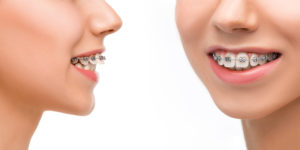
For crooked or crowded teeth and misaligned jaws, braces are the standard treatment performed for most patients. Traditional braces with brackets cemented to the teeth and attached with an archwire help with overbites to straighten the upper front teeth and bring them into a non-protruded position. For extreme cases of overbites and underbites, headwear braces may be necessary. These devices are made with internal and external wires, along with straps that fit over the head and neck, to move the upper jaw either forward or backward. Headwear braces are typically worn for 12-14 hours a day, but are only needed whenever traditional braces cannot fix misalignment. For underbites, an upper jaw expander is recommended to widen the palate of the mouth so that the lower teeth move back into position. The expander is placed in the upper palate of the mouth and widened each night with a special key, and after one year, the palate should be wide enough for both the upper and lower jaws to fit together. For the most serious cases of jaw misalignment, orthognathic jaw surgery will be required. Plates, screws and wires will be surgically placed into the jaw by a maxillofacial surgeon to permanently correct bite problems, which will greatly improve speech and sleep.
Importance of Orthodontic Visits
While many bite problems are obvious, some are so slight that detection will be hard to notice. In these cases, it’s important that children and adults have regular orthodontic visits so that teeth movement and development can be monitored. Orthodontic visits, especially in young children, are essential to observe incoming teeth, reduce the risk of impacted teeth, monitor jaw development and detect hidden dental issues. Not only will your teeth be examined, but your jaws and mouth will be reviewed for signs of underlying conditions, decay and disease, as well as thoroughly cleaned. These visits also provide patients the information they need to establish good dental habits early on to keep their teeth healthy and free from decay both during and after orthodontic treatment.
Get Straighter Teeth With Our Help!
At Belmar Orthodontics, we specialize in helping children and adults alike fix malocclusion, adjust misaligned jaws and get the smiles that they deserve. Whether you or your child has an underbite, overbite or crowded teeth, our team can help you remedy any issue that you are experiencing. Through specialized orthodontic treatment plans and advanced appliances, your mouth issues can be fixed within a short period of time. Call our office today at (303) 225-9016 to get a straighter smile today!
What Foods Should You Eat With Braces?

Whenever you first begin orthodontic treatment, your orthodontist will recommend certain foods that you should avoid, and those which will be good for your teeth. Many times, sugary or sticky foods like candy, gum, corn, and nuts shouldn’t be eaten during the duration of your treatment as they are known to damage braces and increase the likelihood of cavities. While there is a list of foods that you should NOT eat with braces, there are plenty of options that you can still include in your diet that are just as tasty as those that you will have to avoid for a while. Find out what foods you should avoid during orthodontic treatment and what foods you can still enjoy with this guide!
Foods That Are Good
One of the first concerns that patients have as they begin orthodontic treatment involves the food they should and should not eat. A lot of responsibility comes with braces, as you will have to protect them by watching what you eat, cleaning them daily and adhering to your orthodontist’s instructions. To begin, let’s discuss all of the food that you CAN eat during your time with braces. Softer options are your way to go as your mouth gets used to braces, so eating food like chicken, oatmeal, rice, beans, fish, eggs and yogurt are great ways to get a lot of nutrition without breaking a bracket. Even hard fruits, like apples and pears, are good to eat as long as they’re cut into slices or smaller pieces. Don’t think you’ll be able to get away with not eating vegetables during treatment-even the crunchiest of vegetables can be steamed or sliced into slivers, making them perfectly edible for orthodontic patients. You’ll want to eat foods that you don’t need to chew much, especially after an adjustment. Soups and mashed potatoes work perfectly for a sore mouth, and sandwiches and salads (without nuts) can be eaten once you get used to the feel of braces.
Foods To Avoid
Unfortunately, the list for foods that you should avoid during treatment seems to always be much longer than those you should eat. However, the new diet that you’ll be working with for the next several months or years is actually beneficial for you in the long run as most of the food you need to avoid is sugar-filled. Hard and sticky foods are no-nos when it comes to braces; candy, caramel, nuts, chips, licorice, taffy and gum are notorious for breaking wires and brackets, plus they cause cavities. Sugary and starchy foods produce plaque and acid, and the more you eat these foods, the more likely it is that you’ll get tooth decay and gum disease. Hard foods like popcorn and ice can make the impact of braces less effective, meaning a longer treatment time and more money. Additionally, the elastic ligatures that are placed on the bracket itself can be stained by foods with strong colorants, such as berries, grape juice and beets. Even though you may feel like you’re missing out on all of your favorite foods, you’ll be surprised that most foods you love can still be eaten with braces if they’re cut smaller or skinned. You’ll need some creativity when figuring out your meal plan during treatment, but the benefits of keeping your teeth healthy and braces intact outweigh the cons of giving up some of your favorite treats for a while.
Taking Care Of Your Braces
Watching what you eat is just one step in your oral hygiene regimen with braces. First, begin with the basics of brushing and flossing. Take off your elastics and other removable parts of your braces and begin brushing at a 45-degree angle. Clean each tooth and bracket individually in a circular motion, and floss beneath the archwire to remove any leftover food. Flossing can be difficult with braces, so it might be a good idea if you use a floss threader to get in between teeth and under wires. These two steps are essential to thoroughly clean teeth and prevent decay from forming, so make sure that they are a part of your everyday routine. For an additional clean, rinse your mouth with mouthwash to kill bacteria and give yourself fresh breath. Lastly, always go to your orthodontic cleaning and adjustment appointments. The orthodontist will be able to monitor your tooth movement, fix broken brackets, tighten wires, remove plaque and give you pointers on how to take care of your braces.
Get A Beautiful Smile Today
For more information about foods you should and should not eat with braces, call Belmar Orthodontics at (303) 225-9016! Our team has years of experience educating patients on oral health, adjusting brackets and wires and helping patients get the beautiful smiles they deserve. Call today!
Tips For A Tooth-Friendly Independence Day

The Fourth of July offers fun activities full of fireworks, parades and celebrations. From hamburgers to watermelon to all kinds of delicious treats, Independence Day is a fun day for everyone. Amid all the celebrating, though, it’s important that you take care of your teeth by watching what you eat and which activities you participate in, especially when wearing braces. There are lots of food options to choose from, but it’s important to keep your oral hygiene routine in check to prevent tooth decay. Find out how you can enjoy Independence Day and protect your teeth at the same time with these tips!
Commit To A Regular Routine
During this holiday season, our lives go from our normal day-to-day routines to boating, barbecuing and playing with sparklers as we watch the fireworks. The Fourth of July is a week full of festivities that involve a lot of food and fun, but it’s also a time that we easily forget to maintain a good oral hygiene routine. Our daily routine should include how we take care of our mouth and teeth, which means we can’t skimp on brushing and flossing, especially with braces. Plaque loves to sit on teeth as long as it can so that acid can form and eat at your tooth enamel. The longer plaque remains on your teeth, the more likely you are to experience tooth decay. During the week of the Fourth of July, it may be tempting to let your kids skip their normal bedtime routine due to a firework show or a late-night party, but even one night of not brushing and flossing lets harmful bacteria wreak havoc on your child’s teeth. Braces are especially susceptible to the effects of poor oral hygiene as they easily trap food particles around the brackets and underneath the archwire. One tip that can help your kids remember their oral health during the holiday is to keep a brushing calendar. These calendars are simple and easy to use, and they help kids stay on track each day, no matter what busy activity they’re participating in. You can find a brushing calendar at most department stores or you can ask your child’s dentist for one.
Avoid Sugary Foods and Drinks

beautiful blonde child drink water outdoor
One of the biggest mistakes that kids and adults alike make during the Fourth of July involves the type of food that they consume, specifically sugary foods or meals full of starches. It’s hard to resist a juicy burger with a slice of cherry pie, a sugary funnel cake or a cold lemonade, but these holiday foods are full of sugar and starches that not only affect your waistline, but your teeth, as well. Eating lots of foods high in sugar increases your risk of cavities, even if you’re good at brushing your teeth. It’s easy to hand your child a juice box or can of soda while they’re watching the parade, but it’s more beneficial if you offer healthier choices, like water, to keep them cool and hydrated. It’s even better if you can give your child water that contains fluoride, which hardens tooth enamel and safeguards teeth against cavities. For picky kids, milk and fresh juices are also alternatives to sugar-packed sodas and do a good job at protecting teeth. Before all of your fun activities begin, plan out snacks and healthy options for meals that you can provide that will protect kids’ teeth while they’re out having fun. For those with braces, make sure to avoid hard foods like corn on the cob, chips and candy, and don’t forget about sticky foods like caramel, taffy and licorice. Hard and sticky foods are notorious for breaking brackets and wires, which are no fun to deal with on the Fourth of July.
Protect Your Braces
Choosing healthy food options over the holidays is an essential part of protecting braces, brackets and wires. Braces are durable orthodontic appliances, but even they can break from a simple accident, like biting an apple. To maintain the structural integrity of your braces, make sure to brush after each meal (which may be difficult to do when you’re out and about) and use threadable floss to remove pesky food particles from getting stuck. You may even need to use a proxabrush, which is referred to as a “Christmas tree brush” that thoroughly cleans between each bracket whenever normal toothbrushing can’t do the trick. Keeping your teeth and braces clean will prevent tooth decay from developing and will help remind you to watch what you’re eating. Lastly, make sure to schedule regular checkups and cleanings with your orthodontist to remove any plaque that may have built up around your braces and ensure that their functioning correctly.
Schedule A Checkup
At Belmar Orthodontics, we are prepared to help you enjoy this year’s Independence Day by providing dental and orthodontic checkups. Our experienced staff is dedicated to your oral health throughout the entire year, and we can help you and your family receive the beautiful smiles that you deserve. To schedule a checkup or for more tips on how you can protect your family’s teeth this Independence Day, call our office at (303) 225-9016. Your journey to a healthy smile begins today!
Teeth Cleaning Habits To Have With Braces

Good oral hygiene is one of the most important goals that we should all have to maintain the health and strength of our teeth and gums. Once we get braces, however, our oral hygiene regimen will change to account for the new appliance in our mouths that we will have to clean around. Whether you have traditional braces or lingual braces, cleaning around the brackets and wires is essential in preventing cavities and tooth decay. There are many options to choose from to clean between teeth, such as a proxabrush, and other tools to thoroughly brush around the brackets, such as an electric toothbrush. Find out what all you can do to keep your smile healthy and bright with braces with these tips!
Extra Care For Teeth During Orthodontic Treatment
Orthodontic care is one of the most helpful and important dental treatments that patients have readily available to them. While there are many versions of braces that help straighten our teeth and fix misaligned bites, there are certain precautions that we need to take to ensure proper care for our orthodontic appliances and teeth. Brackets and wires in the mouth make it easier for food particles to get stuck in, which can lead to dental problems, like cavities. Proper oral hygiene is essential during your time with braces to avoid any preventable issues that can lengthen your treatment time or need special care to be fixed.
Since braces naturally create nooks and crannies where bacteria can hide, it is important to maintain a good oral hygiene regimen everyday so that you can avoid tooth decay and gum problems during orthodontic treatment. If teeth and brackets are not kept clean, permanent damage can occur to the tooth enamel, as well. When this occurs, white spots (tooth decay) can begin appearing on the teeth where the enamel surface has lost minerals, which cannot be reversed. Bleeding or inflamed gums, called gingivitis, is also common whenever patients don’t clean their teeth thoroughly enough with braces, and it can be very painful. While it is not likely that all of these issues will occur if you miss brushing your teeth or flossing well a few times, you will be more prone to an increased risk, which will hurt your oral health and complicate the rest of your orthodontic care.
Teeth Cleaning Options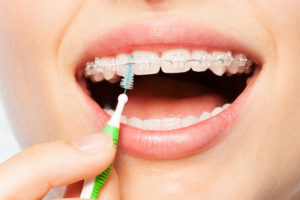
Although cleaning your teeth with braces isn’t too difficult of a process for most patients, there are some tools that you can use to better clean around the hard-to-reach areas in your mouth and make your time cleaning more efficient. First and foremost, make sure that you (or your child) are brushing after each meal. It may seem insignificant, but brushing after you eat removes food particles that are stuck in braces, reduces staining and prevents bacteria buildup. Secondly, use a threadable floss or floss threader to clean underneath the wire of your braces. A floss threader works by inserting the pointed end between the teeth and under the archwire. From there, move it back and forth until it is able to thread the floss between the teeth. Then, you can floss the two teeth, on either side, to remove all food that may be stuck there. If you’re having trouble with your floss getting stuck, consider using waxed floss, which slides between the teeth easier and doesn’t get snagged.
After brushing and flossing, using a proxabrush is helpful in cleaning between each bracket. Commonly referred to as an interproximal brush or “Christmas tree brush,” a proxabrush is placed between two brackets, below the archwire, and uses an up-and-down motion to remove any lodged food particles that brushing and flossing can’t get to. Clean the brackets with the proxabrush on both sides, starting either up from the bottom or down from the top, and repeat between each tooth. Another option for hard-to-reach areas is an oral irrigator, which uses a pulsating stream of water to remove plaque and food debris. Mouthwash is also a helpful tool to kill and bacteria that may have been left after brushing and flossing. For an extra clean, try using an electric toothbrush to maximize cleaning and brush those difficult areas of the mouth that are hard to reach.
Braces-Friendly Diet
The foods we eat and the diet we have affect our oral health and can interfere with orthodontic appliances. Eating sugary or starchy foods can let plaque develop around the brackets, which can lead to cavities, staining or even gum disease. Sticky or chewy foods, such as caramel, taffy, chewing gum and corn on the cob, should also be avoided as they can easily become stuck between brackets and be difficult to remove. Hard foods, such as candy, beef jerky, nuts and popcorn, are also no-nos as they are known to break wires and loosen brackets. If you’re going to eat hard or crunchy foods, such as apples or carrots, make sure to cut them into small, bite-sized pieces to avoid any possible damage.
Regular Orthodontic Checkups
Even if you or your child are following these rules, it is essential that you visit with your orthodontist regularly so that they can monitor teeth movement and adjust any wires or brackets. Your orthodontist or hygienist can show you how to use the tools previously described and give you additional teeth cleaning supplies to aid you during treatment. For more questions about how to clean your teeth with braces or what foods to stay away from, contact Belmar Orthodontics at (303) 225-9016!
Rubber Bands and Braces

Why use rubber bands with braces? Some people have them, and some people don’t need to use them at all. Along with brackets, archwires, and ligatures, rubber bands are just another part of braces. Rubber bands are extremely helpful as they help move the teeth and jaw into proper alignment. They are connected to the actual bracket and help improve your bite. If your jaw is misaligned, read on to discover how rubber bands might be the option to straighten your teeth and jaw at the same time!
Parts of Braces
Modern technology has changed the lives, and smiles, of millions of patients worldwide who have used or currently use braces. Nowadays, braces can be as inconspicuous as we want, with some brackets being attached to the backs of teeth, rather than the front, for a more aesthetic appeal. With the invention of a variety of orthodontic appliances, such as lingual braces, Invisalign, clear braces, and traditional, the patient can decide what braces fits their oral health goals the best. Along with the many types of braces we learn about, there are also other parts of braces that we aren’t as familiar with, such as “bracket,” “archwire,” “springs,” and “ligatures.” We have heard of the different components of braces, but what does an archwire do? How do springs help adjust our teeth? Depending on your needs, your orthodontist will install any of these appliances to help you get the best smile in the shortest amount of time possible.
Brackets are the square part of the braces that are directly attached to the tooth, usually through a cement that bonds it to each individual tooth. They are usually made of steel or clear ceramic, and they guide the archwire into the appropriate placement. The archwire is held by brackets and is designed to guide the movement of the teeth during treatment. They are normally made from stainless steel, but also can be made with titanium. Springs go between brackets and around the archwire and are also made of stainless steel or titanium. They function as a force that opens or closes a space between teeth. The archwire and the bracket are connected through ligatures, which are the little rubber bands that wrap around each bracket to hold the archwire in place. For adolescents, these are usually the best part about braces because they come in a variety of colors that kids can choose from, and are changed after each orthodontic visit whenever the archwire is tightened. Although ligatures are rubber bands, they are not the same thing as interarch rubber bands, which have a major impact on jaw and bite alignment.
Rubber Bands
Interarch rubber bands, commonly known as “rubber bands” or “elastics,” ensure that your child’s teeth are lining up properly. They adjust bite and jaw position, such as an overbite or underbite, and are connected to the bracket with hooks. They create a force to move the teeth in a particular direction, specifically closer together. The top and bottom tooth bracket are connected through these bands, which adjusts the position of the teeth in the mouth and the position of the jaw. These rubber bands are removed during meals as well as while cleaning your teeth and brackets. Usually, they are replaced daily because of the wear they endure and their likelihood of breaking if used for too long. When worn to adjust a misaligned bite, interarch rubber bands are typically worn at all times, except for when eating or cleaning your teeth. If the treatment is only minor, you might only have to wear the bands at night. The consistent tension on the teeth and jaw is what makes these bands effective. If a patient doesn’t wear their bands in the prescribed manner, whether it be the length of time is too short or you’re wearing more bands than normal, this can lengthen treatment time and move your teeth in an unintended way. Not every patient will have to use interarch rubber bands, but if your orthodontic prescribes you to wear them, make sure that you follow his or her directions exactly and take good care of your bands.
Do’s and Don’ts of Braces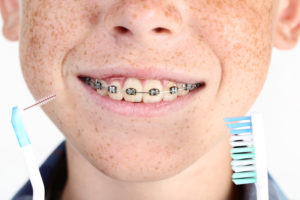
While braces have revolutionized the dental and orthodontic professions, there are some rules that a patient needs to follow to protect and get the most use out of their orthodontic appliances. Always make sure to keep your teeth clean when wearing braces. Brushing and flossing under the archwire and between the brackets is essential to remove plaque, which can easily build up on your teeth with braces. To make sure that your teeth are being cleaned entirely, replace your toothbrush every three months or as soon as the bristles are frayed. Go to all of your orthodontic appointments so that they can adjust your archwire and monitor your teeth’s movement. If you delay your adjustments, your treatment time can be increased, which can be expensive.
Even though braces are strong, you can still break a bracket or an archwire with the things that you eat. Avoid foods that can get stuck in your teeth or your braces, such as nuts, popcorn, hard candy, ice, and sticky foods like chewing gum or caramel. Try not to eat as much sugary foods as it can lead to tooth decay around the brackets, which can permanently damage your teeth. Especially for active teenagers and adults, use a mouthguard during physical activity or when playing a sport to protect your mouth and jaw from getting hurt. Following this list of do’s and don’ts will increase the likelihood of having a positive and shorter experience with braces.
Getting The Smile You Deserve
For other tips and suggestions about orthodontic appliances and which one is best for you, call Belmar Orthodontics at (303) 225-9016 for a comprehensive exam. With our team of qualified and dedicated individuals, we will provide you or your child with the best orthodontic care for a great price. Call now to learn more!
Dental Emergencies With Braces

Braces are incredible devices that can help transform your teeth and reshape your jaws. However, they are not always fool-proof. Every so often, a patient will have a dental emergency. That may be a bad cavity that needs to be fixed, or a bracket or wire will break. There are only a few dental emergencies that can happen with braces. We can help you to know what to do when each of those emergencies happen!
Origins of Braces
Orthodontic treatments have been around for a long time-even as far back as the ancient Egyptians! Although their ways were archaic, people for centuries have been trying to fix crooked teeth and develop a prettier smile through orthodontic work. The ancient Greeks, Romans, and Etruscans were known to have practiced orthodontia, and interestingly, the Etruscans used to attach gold bands to women’s teeth to preserve the position of their teeth after death. Orthodontics saw a surge in progress during the 18th century thanks to Pierre Fauchard. Known as the “Father of Dentistry,” he invented an appliance called a bandeau, which was a horseshoe-shaped piece of metal with regularly spaced holes that fit around the teeth to correct the alignment. He would also use forceps to physically realign teeth into their correct positions and tie them to neighboring teeth until they healed.
Orthodontics in the United States exploded during the 19th century. J.S. Gunnell created a type of headgear that fashioned to the head and exerted a soft pull on teeth while Charles Goodyear invented vulcanized rubber which would eventually become one of the most commonly used appliances in orthodontics. But Edward Hartley Angle, the “Father of Modern Orthodontics,” took orthodontics to another level by identifying the true properties of malocclusion, or misalignment, and addressed them with his own set of orthodontic appliances in 1880. Until the 1970s, orthodontist would attach anchored brackets around each tooth with winding wires, but with the invention of dental adhesives, orthodontists could then stick the brackets to teeth surfaces. Stainless steel then replaced gold and silver as the most popular option for wires, due to its manipulability, and became the most cost-efficient option for braces.
Dental Emergencies and What To Do About Them
Braces have come a long way since their beginnings many centuries ago, but as braces have evolved, so have the problems that come with them. Although dental emergencies are few and far between when it comes to braces, there are some common issues that can be readily addressed and fixed if serious enough. The least serious issues that you can have with your braces is tooth tenderness and lip and cheek sores. As your teeth become accustomed to your braces, your teeth will most likely be sore for 2-4 days. Using headgear, rubber bands, and springs can add to this soreness, but that discomfort normally goes away in the same amount of time. Eating soft foods and taking an over the counter pain reliever can help dull the ache. Loose or broke bands and brackets are also another annoyance that sometimes occur with braces. Although not considered an emergency, they normally break due to patient’s eating prohibited foods or picking at their braces. Whenever this occurs, place a piece of wax on the spot of irritation and wait until your next orthodontic appointment, unless the broken bracket breaks on one of the upper or lower front four teeth, then call your orthodontist as soon as possible.
Protruding wires are not only bothersome, but can stab the inside of your lips and mouth if not fixed. Wires can come loose from eating sticky foods, like candy, or by picking at your braces. If this has occurred, try using a Q-tip or pencil eraser to push the wire in towards the teeth. To avoid accidental damage to the wire, make sure to not bite your nails or pens and pencils. In rare occasions, a piece of the appliance may break and be swallowed by the patient. Although alarming, keep calm and have someone look in your mouth to see if the appliance if visible. If confident that you can remove it, you may carefully attempt to do so. If you are unable to see the piece, are coughing excessively, or having difficulty breathing, that could be a sign that the piece could have been aspirated and you should contact your orthodontist immediately.
How To Protect Your Braces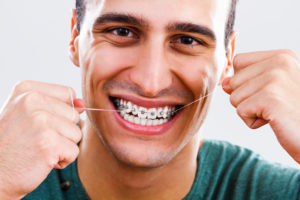
Unless under extenuating circumstances, most dental emergencies are avoidable. Maintaining good oral health and hygiene throughout your time with braces is vital in ensuring healthy teeth and gums, and preventing cavities. Food particles are easier to get stuck between braces, and when not cleaned thoroughly, can lead to other dental emergencies, like tooth decay, which can cause major complications. Hard foods, sticky foods, and foods high in sugar should be avoided as they are known to break brackets and cause cavities, which you more susceptible of developing while wearing braces. Some of the need-to-avoid foods include hard candy, nuts, apples, popcorn, ice, gum, caramel, and licorice.
Because braces are so notorious for getting food stuck in them, make sure that you are brushing after every meal to prevent staining and reducing bacteria buildup in your mouth. Use a soft brush, and brush each tooth by starting at the top and brushing down, then repeating the motion and brushing up around each bracket. Use threadable floss of a floss threader to get the hard to reach areas in between teeth that are covered by the archwire. Using the pointed end, insert between the teeth and gently move the floss back and forth between the two teeth. For added care, use a proxabrush, sometimes called a “Christmas tree brush,” to scrub between each bracket in an up and down motion to get any extra gunk that might be stuck there. For any dental emergencies that you might be having, make sure to contact Belmar Orthodontics at (303) 225-9016 for your next consultation!
Braces: How Are They Made?
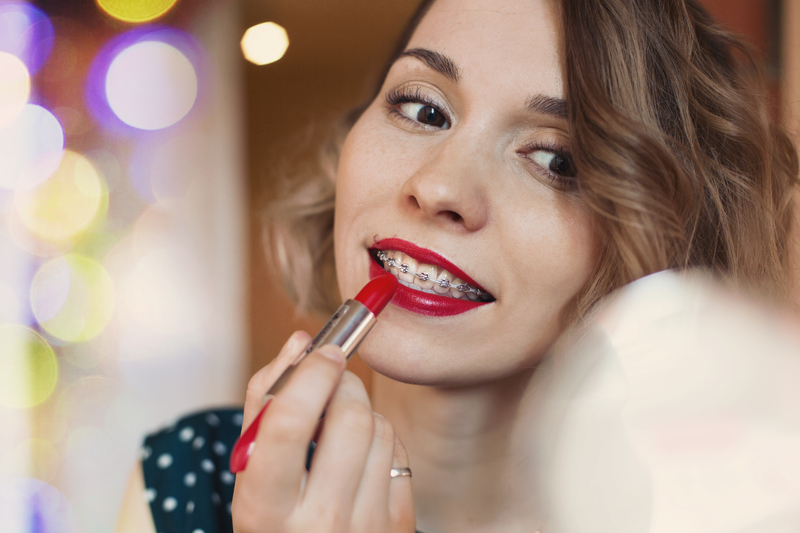
You may wonder what the differences are between metal, ceramic, and lingual braces and how they compare to Invisalign treatment. All are a bit different and they are both made and worn differently. Braces are made from various materials and designed specifically for your mouth.
Metal Braces and Your Teeth
You’ve likely seen someone wearing metal braces and you know that they make your teeth straighter. But how? It takes a bit of science and the right orthodontic appliance to make that beautiful smile happen. With the most common type of braces—metal braces—you have a stainless steel material that is shaped into specific orthodontic parts that will all go together in your mouth. Often those parts are molded and shaped in a special lab that then ships those parts to orthodontists.
Labs will even do custom-made brackets and wires for patients when the need arises. However, most braces have a specific design like metal braces do. Metal braces have several parts that include:
- Brackets: These stainless steel pieces are those little squares bonded to the middle of each tooth. We use a special bonding glue that will stay on your teeth for the entire duration of your treatment, but will come off easily with the right orthodontic material. Your brackets are small anchors that hold a wire in place. They will have tiny rubber elastics placed around them to protect your teeth and prevent stuck food.
- Archwire: This metal wire will pass through the brackets on each tooth, all the way to the back of your mouth. Many patients have a bracket that wraps around the back molar that stabilizes this archwire. The wire will follow the curve of your jaws in an elongated have circle. When a thicker archwire is placed or when this archwire is adjusted, it can help move the teeth into place because of the force placed on the brackets.
- Ligature Elastics: These are the rubber elastics we mentioned. The elastics are what keep the archwire sturdy so it can straighten your teeth.
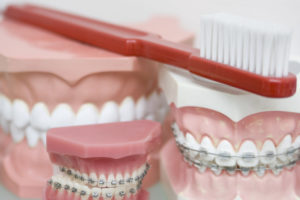
How Teeth Straighten
Your archwire will be adjusted very slightly at your orthodontic appointments every 4-6 weeks. That slight adjustment may seem very small, but it’s what your mouth needs to make a true, straightening change. The appliance is not the only thing changing your teeth into a straighter position. Your teeth are the hardest substance in the body and can even be harder than many metals. Straightening them would seem very difficult, when it’s not. It simply takes time.
Your teeth can take a ton of force from chewing, biting, eating, talking and other actions because they are rooted into your jawbone. However, the jawbone is much weaker than the teeth are. So why doesn’t your jawbone get breaks in it when you chew hard things? You have something called the periodontic ligament that is around every tooth root as it goes into your jaw bone. All those ligaments are shock absorbers for your jaws when you chew, minimizing the force your jawbones take. These are key to straightening the teeth.
When orthodontic appliances are on the teeth, they will apply a very slight pressure to your teeth and to the periodontic ligaments that surround them. When that pressure is constantly there, your body will produce acids in the jawbone area that will break down tiny parts around the teeth. With new space created, the teeth can shift. Your body will naturally deposit more minerals in areas that have changed to strengthen the jawbone once more. Over time, your jaw is literally breaking itself down on a microscopic level and then rebuilding itself. That is why orthodontic treatment takes months. However, the result is worth it.
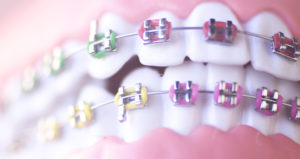
Ceramic and Lingual Braces
Ceramic and lingual braces are very similar to traditional metal braces, but are made a bit differently. Lingual braces are also a metal braces type, and most types are made from stainless steel in a lab. There can be other types of metal used or a combination of metals. These braces will have brackets and wires just like traditional metal braces, except that they will be placed on the back of a patient’s teeth.
Because of placement, children are not usually candidates for lingual braces because of the size of the teeth. Dental impressions of the back of the teeth are made so that metal coverings can be made for the tooth backs, which is a bit different than traditional metal braces. More anchoring is needed with lingual braces, and this is how it is done. The metal material will cover the entire tooth back with a bracket in the center of the tooth, and each is placed individually when a patient gets their appliance. The archwire works the same as other braces.
Ceramic braces are very similar to metal braces in their design and how they work. However, they are made from ceramic material, which is naturally white already. This makes the braces blend in with the teeth more, and the metal can even be frosted to blend in with whiter teeth.
Invisalign: Customized to the Patient
Invisalign treatment is an orthodontic option that is vastly different than your other options. The most noticeable difference is that there is no metal or ceramic material in your appliance. A patient will have digital images taken of their mouth. With that image, custom aligners are made that a patient will switch out each week. These are a type of plastic material patented by the Invisalign company. It’s a strong enough plastic to cause the same type of shifting you want your teeth to do. Aligners fit snug in the mouth as they are custom made, are switched out each week, and must be worn 20-22 hours of the day. If you are interested in any of these types of braces or want to see how the braces are put on a patient, call Belmar Orthodontics today at (303) 225-9016 with your questions!
Receiving Dental Care with Braces
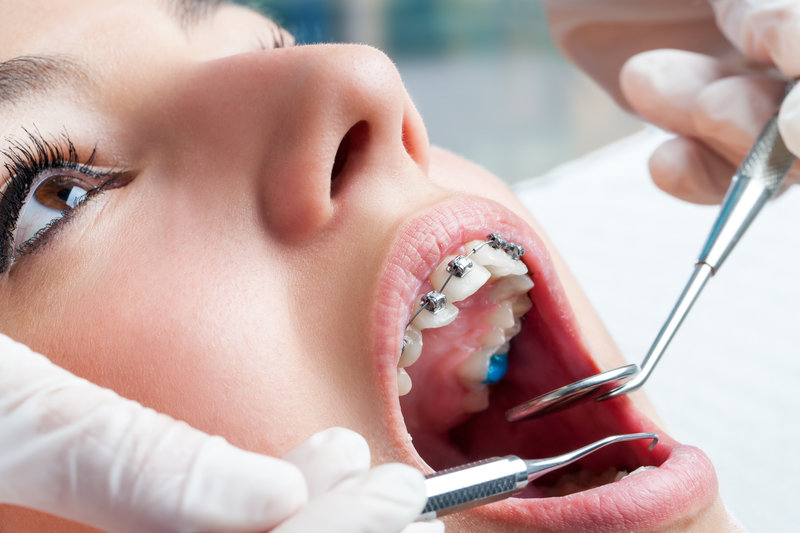
Dentist hands working on young teen patient with dental braces.
Should you receive dental care with braces or is seeing the orthodontist sufficient? Continue regular checkups with your dentist even if you are frequently seeing your orthodontist. Braces make you more prone to problems such as plaque buildup and tartar. Depending on the kind of braces you choose, your teeth may require additional steps to stay clean with braces than without. For some, the enamel can also weaken with braces. However, there are ways to keep your teeth healthy and clean while you have braces. Modern-day orthodontics offers treatment options everyone can be comfortable with and will still allow patients to receive proper dental care at the same time. We can answer frequently asked questions for receiving dental care with braces and help you with tips for taking care of your braces so your smile stays healthy.
Dentists and Orthodontists
Did you know that orthodontists attend dental school just like dentists do? Dentists and orthodontists are similar in their schooling up to a point. However, although both professions deal with the health of your teeth, they both do separate services. Dentists perform services such as:
- Comprehensive exams and diagnostic x-rays
- Dental cleanings
- Oral cancer screening
- Laser tissue treatment
- Periodontal treatment/Scaling and root planing
- Dental sealants
- Cavity fillings/Tooth colored fillings
- Sedation dentistry
- Porcelain veneers and crowns
- Cosmetic bonding
- Dental bridges and dental implants
- Root canal therapy
- Teeth whitening
An orthodontist performs other services different than a dentist, although they are skilled in dental practices. Orthodontists receive 4 years of undergraduate education, where they then attend dental school for 4 years. After dental school, they attend a postdoctoral program to learn orthodontia. A dentist fixes problems with your teeth in general, while an orthodontist fixes problems with teeth alignment as well as your bite and jaw alignment. Basically, every orthodontist is a dentist, but not every dentist is an orthodontist. Patients benefit from having both a dentist and an orthodontist to maintain a healthy mouth.
Caring for Your Teeth
Taking care of your teeth is a bit different with braces than it was without them. During your orthodontic treatment, it is particularly important to maintain good oral health through proper oral hygiene. Brackets and wires in your mouth make it much easier for food particles to get stuck. When those food particles are not removed, it leads to other dental issues like tooth decay (cavities) and gum disease. Your teeth may also demineralize or erode in the areas where your brackets were attacked to the teeth. Areas on the enamel surface lose minerals in this case, which is what causes white squares to form on the teeth. If you drink beverages that stain the teeth easily, you might be left with uneven stains once the brackets have been removed.
With braces, you should still follow the American Dental Association’s recommendation to brush the teeth at least twice a day. We recommend that you brush the teeth much more than that, as food particles can get stuck in the brackets at every single meal. Make sure to avoid hard foods like hard candies, chips, apples, nuts, popcorn and more with your brackets. Also avoid sticky foods such as gum, caramel, taffy, tootsie rolls, and gummies as these foods are much harder to get out of all the small areas of your braces. A lot of caring for your braces is watching what you eat and then cleaning the teeth often after you do eat.
Cleaning with Braces
Flossing is one of the daily tasks that will be more difficult with braces because there is an archwire that blocks the floss from going in and out of the spaces between the teeth with ease. The solution for this is to use threadable floss or a floss threader. With a floss threader, you use regular floss and thread it through the eye of the threader much like you would with a sewing needle and thread. You then floss the threader between each tooth individually. Floss that comes threadable will be harder at one end and will be able to be threaded between the teeth without having to have a separate threader.
After brushing with a toothbrush, you can also use a proxabrush, which looks like a small Christmas tree brush. You place this proxabrush between two brackets, below the archwire, and you brush up and down. This will get food that is hard-stuck in your brackets. Brushing after every meal will reduce how much food gets into your bracket and stays there.
Dental Care with Braces
Even though you are seeing an orthodontist frequently, you must continue to visit your dentist throughout your care! An orthodontist will get your teeth straight, but you receive dental cleanings, comprehensive exams, and cavity care from a dentist, not an orthodontist. Both professions deal with the teeth, but they both deal differently with the teeth. Only a dentist can find cavities and fill them for you. A dentist can provide all the services we listed above, which are all very important to keep the teeth healthy. Receiving frequent dental exams and cleanings are some of the best dental services you can receive while wearing braces, because keeping the teeth clean and free of cavities will help your smile be that much more beautiful in the end.
Schedule a Dental Visit
Your tooth enamel can suffer permanent damage if you don’t take extra care with your teeth with braces. That’s why it’s even more important to receive dental care while you have braces. Be vigilant with your oral hygiene every single day. Don’t skip days! You are spending months of your life to receive a straighter smile. You want that smile to also be a beautiful one at the end of your treatment. In the end, it is very important to receive dental care during braces and to take care of them yourself every day at home. If you have questions about caring for your braces, call our Belmar Orthodontics office today at (303) 225-9016.
Incognito Lingual Braces Vs. Traditional Metal Braces
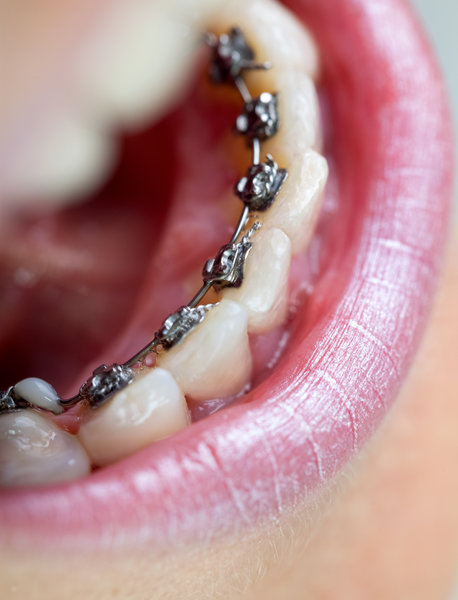
Young woman with lingual braces
There are many services we offer when it comes to straightening the teeth, including Incognito lingual braces and traditional metal braces. These two options are very similar, however, lingual braces are made slightly different than traditional metal braces because of where and how they are worn. Both will give you amazing straightening results and both are services we provide. What choice is right for you? Which is best for your budget and for your time? We can help you know the difference between Incognito lingual braces and traditional metal brackets and help you choose which option you’ll love the most. As always, with professional orthodontic care through Belmar Orthodontics, you can be sure you receive quality straightening power no matter what option you choose.
Investing In Braces
When you invest your time in braces, you are making an investment for the rest of your life. Your smile is one of the first physical features others see. Is that smile making an impression? We want all of our patients to have beautiful, healthy smiles. Why? Beautiful smiles are quite attractive to others. In studies, those with a straighter, more beautiful smile are seen as more attractive, trustworthy, confident and successful. Straighter smiles tell others that you take care of yourself.
When it comes to your health, a straighter smile can also help reduce your risk for tooth decay and gum disease. This is because the teeth are aligned and much easier to clean, especially in between the teeth. Plaque has a harder time staying stuck on the teeth and causing problems when the teeth are easier to clean. So when it comes to both aesthetic and health reasons, braces can really change your life! There are many options when it comes to choosing the right braces for you. Some of the most popular options in orthodontics are traditional metal braces and Incognito lingual braces.
Traditional Metal Braces
These are the braces you probably imagine when you think of braces. They are traditional because they’ve been around for decades and are proven to straighten your teeth effectively. Traditional metal braces are worn on the front of the teeth. In times past, the term “metal mouth” was a term some used to describe those who had these braces. However, studies have shown that braces have become a luxury in modern times.
Traditional metal braces are more popular than ever, especially among teenagers. Metal braces have also taken on a much smaller and sleeker design so you no longer have a mouth so full of metal. The best part about traditional metal braces (besides how well they work) is that they are also the least expensive option when it comes to orthodontic care. You can also dress up these braces with bright bands of color and express yourself the way you want.
Incognito Lingual Braces
Love the idea of metal braces but don’t exactly love how noticeable they are? We are excited to be able to offer our patients an alternative to traditional metal braces: hidden lingual braces. There are about 4.5 million Americans that currently wear braces. Of those, 25% are adults. The majority of the rest of braces wearers are teenagers. It is common for some adults and teenagers to avoid orthodontic treatment because they find metal braces to be unattractive or distracting. However, most people love to have straighter teeth. The solution? Incognito lingual braces!
With lingual braces, you can achieve the same results as traditional braces with a hidden treatment apparatus on the tongue-side of your teeth (by the tongue and palate). This is why they are referred to as “incognito” braces—they stay hidden (or incognito) as you straighten. We will take an impression of your teeth and make customized brackets fit perfectly to you. Lingual braces work much like traditional metal braces by slowly shifting the teeth into proper alignment. Unlike metal braces, each tooth must have its own installment of brackets and wires, as the lingual braces are shaped to each tooth back. Special training and technical expertise are needed to install these braces, and they do cost a bit more than traditional metal braces. However, you receive the trade-off of these braces being so undetectable.
Other Braces
There are more options than just traditional metal braces and Incognito lingual braces. We also offer:
- Invisalign – For those seeking an option that goes beyond Incognito braces, they can invest in Invisalign. This is a series of transparent aligners that are replaced every 1-2 weeks. They are virtually invisible and can be removed for eating, drinking, cleaning and sports.
- Ceramic Braces – Made from ceramic material, these white braces seek to have the functionality of traditional metal braces while blending into the teeth. Both the brackets and the wires can be made white so the braces are hard to see against the teeth.
Getting Your Braces
When it comes to receiving your braces, we want to give you options so that you truly enjoy your braces experience. Both traditional metal braces and lingual braces will work hard to straighten your smile. The dentists at Belmar Orthodontics have the expertise, training and experience to install both traditional metal braces or Incognito lingual braces to your smile. To start your orthodontic treatment with metal or lingual braces today, call our Belmar Orthodontics office today at (303) 225-9016!

